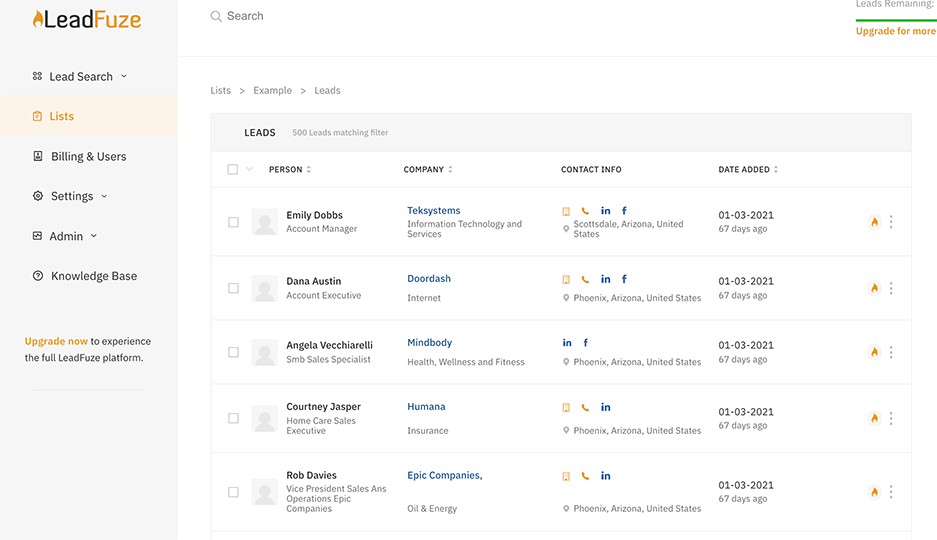If you’re in sales, you know that building trust with your prospects is the key to success. But how do you go about doing that? In this blog post, we’ll share some tips on how to talk to prospects and build trust with them.
Knowing where to start when talking to a prospect can be difficult. After all, you want to ensure that you come across as knowledgeable and trustworthy without sounding like a used car salesman. Read on to learn how to talk to prospects and close more deals!
How to Talk to Prospects: The Do’s and Don’ts
Trade shows are a great place to meet new potential customers. While being polite is nice, it won’t help you engage with your trade show attendees. Instead, you should focus on having more meaningful conversations.
When meeting with a prospect, your focus should be on asking questions that will help you identify their needs.
Asking the right question at the right time can direct a conversation to the desired result.
It’s time to prep for trade shows! Gather up your team, book your flight, and get ready to expand your reach.
Trade shows are a great opportunity to meet new potential customers. Having a plan going into the event will help you make the most of it.
The trade show opens once the team is ready and people start pouring in.
Your fun giveaways are a great starting point and the result of your successful marketing efforts.
Once you’ve identified your lead, it’s time to call them. This can be a bit tricky, but don’t worry.
Here are some helpful tips for talking to your trade show attendees and capturing and qualifying potential business connections.
Opening Questions
Your openers are questions that you ask to introduce yourself, determine their needs, and figure out their challenges and brand awareness. Some sample openers might include:
- What are your objectives and goals for the trade show?
- What challenges are you experiencing with your current product or service?
- Brand recognition is important to gauge with potential customers.
- Have you heard of our brand or product/service before?
- These are all important questions to ask to understand the customer better.
Investigative Questions
After you’ve asked your basic qualifying questions and gotten your prospective client to answer them, it’s time to ask more pointed questions that may help you identify them as a lead.
Examples of good questions to ask during an investigation are:
- What product/service are you currently using?
- What do you like and dislike about it?
- How much are you looking to spend?
- What are your top three must-haves for a product/service?
Demonstrative Questions
During your pitch, ask open-ended questions that will prompt your prospect or lead to talk. This can give you a better idea of their interest level in the product or service and can also give you insight into their buying behavior.
Try asking some demonstrative questions that get the prospect talking.
- What do you think of our product/service capabilities?
- How does it compare to the one you use now?
- You’ll be impressed with how much better our product/service is than what you use now.
- Do you have any concerns or questions regarding our product or service?
Closing Questions
What are some benefits of closure in marketing and sales? How can good closure questions encourage a follow-up action for the prospect or lead?
Here are some examples:
- What is your company’s process for deciding which vendors to use?
- Are there specific criteria that must be met?
- Are there certain departments that are responsible for this decision?
If you’re interested in learning more, please let me know. I’m happy to help.
If they’re not interested in learning more…Can I ask what specific areas you were hoping our product service would address for your company? I’d be happy to provide additional information that may help you make a decision.
A conference room on-site can help you boost lead generation. A meeting room allows your sales team to show additional capabilities and come up with customized solutions for the interested parties.
If you don’t have an on-site conference room available at the trade show, get the prospect’s contact information so you can set up a future appointment. Be sure to get their blessing before collecting any information.
Lead Capturing and Qualification
Using technology at your trade show booths is a fantastic way to capture and qualify more visitors. Not only is it more engaging for your prospects, but it also allows you to collect more qualified data.
Lead capture technology can be extremely beneficial for companies that invest in trade shows. A great way to capture leads is by using generated dynamic QR codes. By scanning a visitor’s badge, you can easily collect their information and qualify them as potential leads.
These 2D barcodes are typically printed on attendees’ name tags at events, making it simple for sales reps to capture their contact information.
Analyzing this data, companies can gain valuable insights into how their booths are performing, attracting visitors, and which of their tactics are most effective.
If you want to capture and qualify leads at your next trade show, consider using QR code-enabled merchandise. This will help engage visitors and encourage them to take further actions, such as filling out a lead form, checking out your products or services online, watching a video or presentation, and more. By collecting this data, you can later analyze your booth’s traffic performance, sort leads, and use these insights to improve your strategy for future trade shows.
Marketing Activities After The Trade Show
It is important to reach out to your leads. Allow your contacts to settle down at the office before sending your follow-up. But don’t wait too long. Send a lead-nurturing email as soon as possible while the lead is still hot.
Maximizing your post-show marketing will make a big difference in achieving a positive return for your trade show investment. A well-written email can make or break your conversion success. It should be tailored to each lead.
Remember to clearly state who and what you are, the company you work for, and the trade show where you met. Looking for inspiration? Below is an example.
Follow-up Email:
Hello [lead name],
It was a pleasure to have met you at [tradeshow event name]. I hope you enjoyed the keynote speaker and learned a lot from the breakout sessions.
You mentioned that [lead’s company] is looking at [lead’s pain point], so I wanted you to contact me to discuss how [your firm] can help you achieve your goal.
I would love to schedule a call with your to answer any questions and discuss the next steps. Is there a time in your schedule this week to have a 15-minute conversation? I look forward to speaking with you.
We are grateful to
[your contact info & name]
How you meet your marketing objectives will determine the success of your tradeshow. Before the big day, review the goals you set for your team and remember them when talking to prospects. Converting prospects into leads and leads into customers is a great way to make a difference and help you decide which shows are worth attending next year.
How to Sell to a Tight-Lipped Prospect
Prospects who won’t tell you anything over the phone aren’t necessarily being rude; they’re just being cautious. Their reluctance to talk on the phone is a defensive measure, not an offensive one.
They may have been burned in the past by giving up too much information and feeling like they were manipulated into a bad deal. It’s important to show that you’re trustworthy and will only use their information to benefit them.
It’s because people don’t trust you. Before making a sale, you need to prove your good intentions.
Proceed with caution; advanced techniques follow, only for seasoned pros. If you’re new to selling, take our free training.
The sales prospecting cycle involves three stages. In the first stage, your prospective client tells you about their situation. In the second stage, you tell them about your solution. In the third stage, you and the client decide whether or not to work together.
But what if your lead refuses to share their situation with you? Then you can’t sell them your solutions.
When you encounter a prospect who isn’t open to you, it’s best to address it head-on. Something like this:
I’m sure you’ve had bad experiences with salespeople before. I’m not here to take advantage, but I want to make sure I explain everything to you clearly.
For us to help each other, I need you to be open and honest with me. It’s ok to be a little uncomfortable, but for me to help you, I need to know your wants and needs.
I want to make sure that our software is right for your needs before we move forward with anything. If I don’t think it’s the right fit, I’ll let you know.
And I won’t sell you anything.
I want to help you, but I need you to be honest with me. Let me know what you want, and I’ll tell you if it’s possible. If it’s not, then I’ll help you find someone who can help you.
Sounds good?
If your prospect isn’t answering, they might feel defensive. Most of the time, they won’t realize they’re being rude until you point it out. Be polite but firm when conveying your message.
Many people will warm up once they understand that you have their best interests.
But not always.
Trust is the foundation of every sale.
Just because a prospect bought something a certain way doesn’t mean you have to sell it to them the same way. Sales should be about honesty and openness.
If your lead isn’t willing to meet you, move to the next prospects.
Conclusion
Talking to prospects is a great place to start if you’re looking to improve your sales skills. By following these tips on how to talk to prospects, you’ll be on your way to building trust and developing relationships with your prospects. And remember, always be honest and don’t be pushy – let them come to conclusions about what they need.
Need Help Automating Your Sales Prospecting Process?
LeadFuze gives you all the data you need to find ideal leads, including full contact information.
Go through a variety of filters to zero in on the leads you want to reach. This is crazy specific, but you could find all the people that match the following:
- A company in the Financial Services or Banking industry
- Who have more than 10 employees
- That spend money on Adwords
- Who use Hubspot
- Who currently have job openings for marketing help
- With the role of HR Manager
- That has only been in this role for less than 1 year
Want to help contribute to future articles? Have data-backed and tactical advice to share? I’d love to hear from you!
We have over 60,000 monthly readers that would love to see it! Contact us and let's discuss your ideas!

